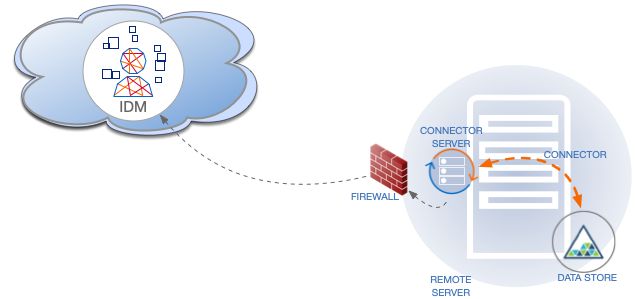Configure a Remote Connector Server (RCS)
Important
Connectors continue to be released outside the IDM release. For the latest documentation, refer to the ICF documentation.
RCS runs in one of two modes:
- Client mode
In client mode, RCS initiates the connection with a server. Run the RCS in client mode if your data store is protected by a firewall or DMZ.
The following diagram shows an RCS in client mode:
- Server mode
In server mode, RCS acts as the server, with IDM acting as a client. IDM initiates the connection to the RCS. Run the RCS in server mode if IDM can initiate the connection and has access through any firewalls.
The following diagram shows an RCS in server mode:
This example shows how to retrieve the RCS types over REST:
curl \ --header "X-OpenIDM-Username: openidm-admin" \ --header "X-OpenIDM-Password: openidm-admin" \ --header "Accept-API-Version: resource=1.0" \ --request POST \ "http://localhost:8080/openidm/system?_action=availableConnectorServers"{ "connectorServers": [ { "displayName": "Remote Connector Server", "systemType": "provisioner.openicf", "type": "remoteConnectorServer" }, { "displayName": "Remote Connector Servers Group", "systemType": "provisioner.openicf", "type": "remoteConnectorServersGroup" }, { "displayName": "Remote Connector Server in Client mode", "systemType": "provisioner.openicf", "type": "remoteConnectorClient" }, { "displayName": "Remote Connector Servers Group in Client mode", "systemType": "provisioner.openicf", "type": "remoteConnectorClientsGroup" } ] }
Configure RCS in Client Mode
Important
Connectors continue to be released outside the IDM release. For the latest documentation, refer to the ICF documentation.
The RCS configuration will differ between server mode and client mode. See RCS Properties for a list of properties that are specific to each mode, and which are used by both configurations.
To generate the core configuration, use the createConnectorServerCoreConfig action on the system endpoint. Include at least the RCS type (remoteConnectorClient) and the systemType in the JSON payload. The systemType is always provisioner.openicf, regardless of the RCS type:
curl \ --header "X-OpenIDM-Username: openidm-admin" \ --header "X-OpenIDM-Password: openidm-admin" \ --header "Accept-API-Version: resource=1.0" \ --header "Content-Type: application/json" \ --request POST \ --data '{ "type": "remoteConnectorClient", "systemType": "provisioner.openicf" }' \ "http://localhost:8080/openidm/system?_action=createConnectorServerCoreConfig"{ "displayName": "", "name": "", "enabled": true, "useSSL": false }
IDM returns the basic configuration properties for an RCS in client mode. The configuration that is returned is not functional. It does not contain the required configuration property values, such as the name of the RCS.
Use the output returned in the previous example to create your complete RCS configuration. Specify at least the name of the RCS, and use a PUT request on the config endpoint. Note that this step creates an RCS configuration on IDM. The values of these properties must match the RCS configuration, specified in the ConnectorServer.properties file on the RCS:
curl \ --header "X-OpenIDM-Username: openidm-admin" \ --header "X-OpenIDM-Password: openidm-admin" \ --header "Accept-API-Version: resource=1.0" \ --header "Content-Type: application/json" \ --request PUT \ --data '{ "_id": "provisioner.openicf.connectorinfoprovider", "connectorsLocation": "connectors", "enabled": true, "remoteConnectorClients": [ { "displayName": "On premise 1", "name": "onprem", "enabled": true } ] }' \ "http://localhost:8080/openidm/config/provisioner.openicf.connectorinfoprovider"{ "_id": "provisioner.openicf.connectorinfoprovider", "connectorsLocation": "connectors", "enabled": true, "remoteConnectorClients": [ { "displayName": "On premise 1", "name": "onprem", "enabled": true } ] }
Configure RCS in Server Mode
Important
Connectors continue to be released outside the IDM release. For the latest documentation, refer to the ICF documentation.
The RCS configuration will differ between server mode and client mode. See RCS Properties for a list of properties that are specific to each mode, and which are used by both configurations.
To generate the core configuration, use the createConnectorServerCoreConfig action on the system endpoint. Include at least the RCS type (remoteConnectorServer) and the systemType in the JSON payload. The systemType is always provisioner.openicf, regardless of the RCS type:
curl \ --header "X-OpenIDM-Username: openidm-admin" \ --header "X-OpenIDM-Password: openidm-admin" \ --header "Accept-API-Version: resource=1.0" \ --header "Content-Type: application/json" \ --request POST \ --data '{ "type": "remoteConnectorServer", "systemType": "provisioner.openicf" }' \ "http://localhost:8080/openidm/system?_action=createConnectorServerCoreConfig"{ "displayName": "", "proxyPassword": null, "proxyHost": null, "enabled": true, "useSSL": false, "proxyPort": 8080, "port": "", "name": "", "host": "", "proxyUser": null, "housekeepingInterval": 600, "connectionGroupCheckInterval": 900, "pingPongInterval": 300, "key": "password", "webSocketConnections": 2 }
IDM returns the required configuration properties for an RCS in server mode. The configuration that is returned is not functional. It does not contain the specific property values, such as the host name and port of the RCS.
Use the output returned in the previous example to create your complete RCS configuration. Specify at least the host and port of the RCS, and use a PUT request on the config endpoint. Note that this step creates an RCS configuration on IDM. The values of these properties must match the RCS configuration, specified in the ConnectorServer.properties file on the RCS:
curl \ --header "X-OpenIDM-Username: openidm-admin" \ --header "X-OpenIDM-Password: openidm-admin" \ --header "Accept-API-Version: resource=1.0" \ --header "Content-Type: application/json" \ --request PUT \ --data '{ "_id": "provisioner.openicf.connectorinfoprovider", "connectorsLocation": "connectors", "enabled": true, "remoteConnectorServers": [ { "type": "remoteConnectorServer", "displayName": "Remote Connector Server 1", "proxyPassword": null, "proxyHost": null, "enabled": true, "useSSL": false, "proxyPort": 8080, "port": 8759, "name": "rcs1", "host": "rcs.example.com", "proxyUser": null, "housekeepingInterval": 600, "connectionGroupCheckInterval": 900, "pingPongInterval": 300, "key": "Passw0rd", "webSocketConnections": 2 } ] }' \ "http://localhost:8080/openidm/config/provisioner.openicf.connectorinfoprovider"{ "_id": "provisioner.openicf.connectorinfoprovider", "connectorsLocation": "connectors", "enabled": true, "remoteConnectorServers": [ { "type": "remoteConnectorServer", "displayName": "Remote Connector Server 1", "proxyPassword": null, "proxyHost": null, "enabled": true, "useSSL": false, "proxyPort": 8080, "port": 8759, "name": "rcs1", "host": "rcs.example.com", "proxyUser": null, "housekeepingInterval": 600, "connectionGroupCheckInterval": 900, "pingPongInterval": 300, "key": { "$crypto": { "type": "x-simple-encryption", "value": { "cipher": "AES/CBC/PKCS5Padding", "stableId": "openidm-sym-default", "salt": "3Mq1UJuZXqANx2AzUtbFbg==", "data": "4WHBEI3nSVWJ2DfIs2dPZg==", "keySize": 16, "purpose": "idm.config.encryption", "iv": "BvFAQ4sjwJCNY2e7WZPkGw==", "mac": "ximBz/BlqC8SEsBTuYQX5Q==" } } }, "webSocketConnections": 2 } ] }

